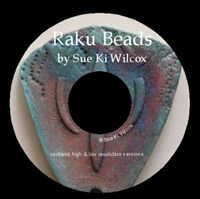|
- Article - Site Navigation Home Raku Artist Bio Raku Gallery Free Raku Glazes Raku Define Raku Links Raku Articles Raku Books |
Resist-ing the Temptation of GlazeSometimes with Raku, what you don't glaze is as exciting as what you do glaze and there are many methods of keeping portions of a piece free of glaze. In most cases, unglazed sections of a piece will turn black as smoke is absorbed into the bare clay during the reduction process. This is something to keep in mind that is different than other firing techniques. With other firings, unglazed clay typically remains clay color (white, buff, red, etc.) but with Raku the unglazed clay will turn black. In most cases you will want to keep the foot of you piece free of glaze. This can be done with the use of a wax resist or masking tape. You can either dip the piece in a shallow pan of wax resist or brush a band around the bottom of the piece. As an alternative you can use masking tape and place a band of tape around the bottom of the piece. Either method should keep the piece free of glaze when spraying or brushing on glaze. If you dip the piece, the bottom of the piece will need to be waxed or covered with tape as well. When the glaze has dried on the pot, you can take a damp sponge and remove any beaded glaze on the wax resist or remove the tape that has been applied. When removing the tape, make sure the glaze dust that is produced does not land on sections of the piece that you want to keep bare. As a decorative effect you may want to leave part of the rim clear of glaze as well. This can be done just like the foot, with either a band of wax resist or a band of tape. In many cases I like to have a black band of bare clay at the top and bottom of my pieces. In addition to the foot and rim, resist techniques can be used to provide some definite order and design to the dynamic and variable Raku process. You can use narrow strips of tape to create geometric designs (like southwestern or Celtic patterns). There are several examples of this on my website. You can draw the pattern on the piece and then place tape strips or brush wax resist over the design. Tape strips will provide a much more exacting and precise line, but you have to make sure the tape is strongly attached to keep the glaze from seeping under the tape. Sometimes it is interesting to combine or overlap glazes on a piece, but sometimes the "mixing" is undesirable. Strips of tape or resist can be placed as a divider between different glazes to make sure they don't "mix" during the firing process. This can produces a very distinct stained glass like affect depending on the pattern and glazes used. Other patterns can be placed on a piece as well. For example, Chinese characters can be brushed on a piece using wax resist before the piece is glazed. Then the finished product will show a dark pattern in the unglazed clay surrounded with the Raku glaze. Templates can be cut out of self-sticking shelf liner and placed on a piece to provide additional patterns, such as leaves, birds, symbols, or any other complex shape that is not easily painted with wax resist or created with strips of tape. One thing you may want to consider when using these resist techniques is the amount of glazed that is applied right next to the resisted section. If a large amount of glaze is applied, and the glaze is runny at all, the intricate pattern you created may be ruined with drips. Good Luck and Happy Resisting. |
||
|
Books
Learn Dozens of Hints, Tips and Techniques in the free monthly newsletter Just
Raku Privacy Policy - Your email address or other personal information will only be used for this newsletter. It will never be given, rented, or sold to any other party for any other purposed. |
||
|
Gary R. Ferguson - Raku Artist (c) Copyright 2005, Gary R. Ferguson |
||




